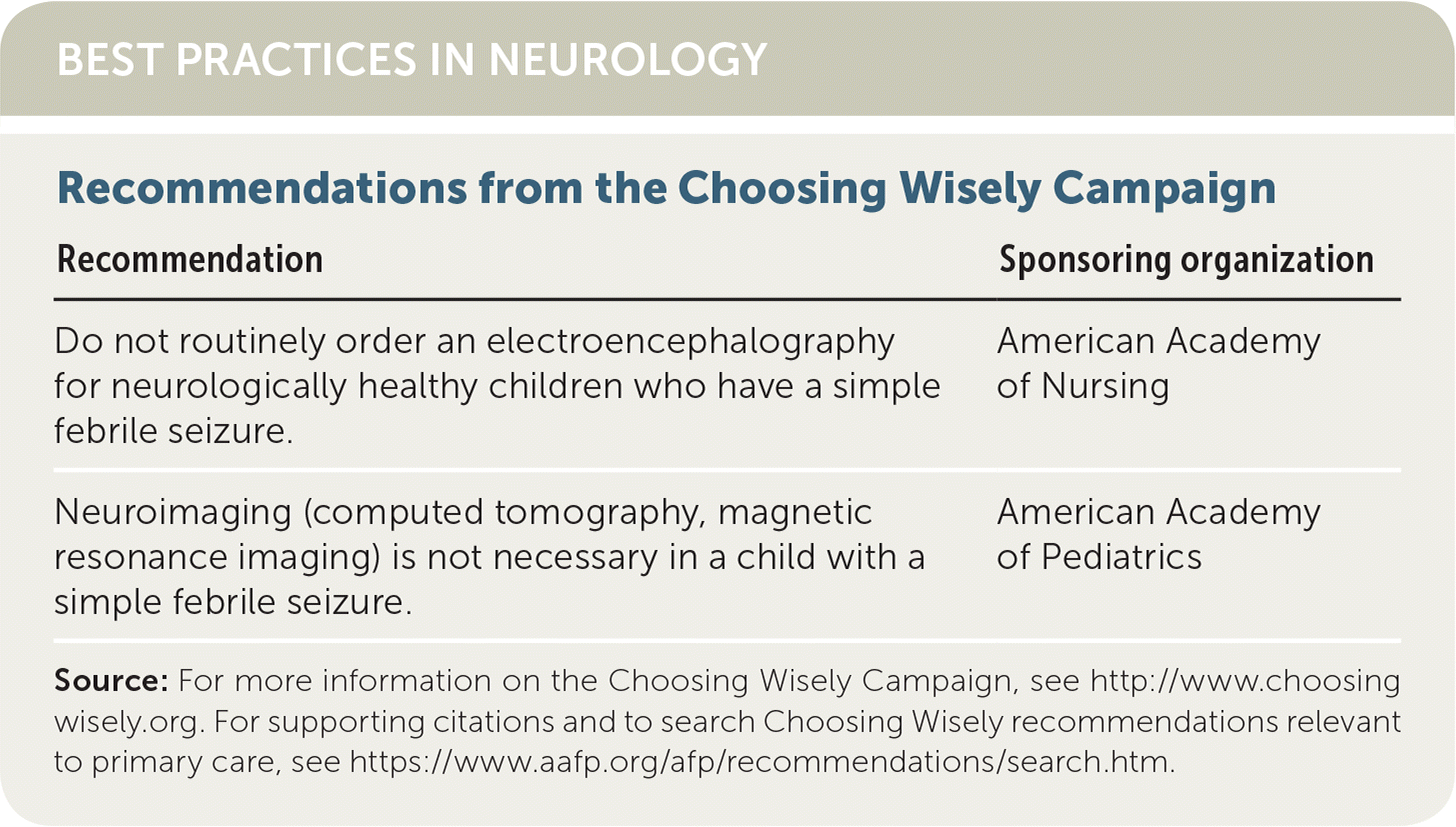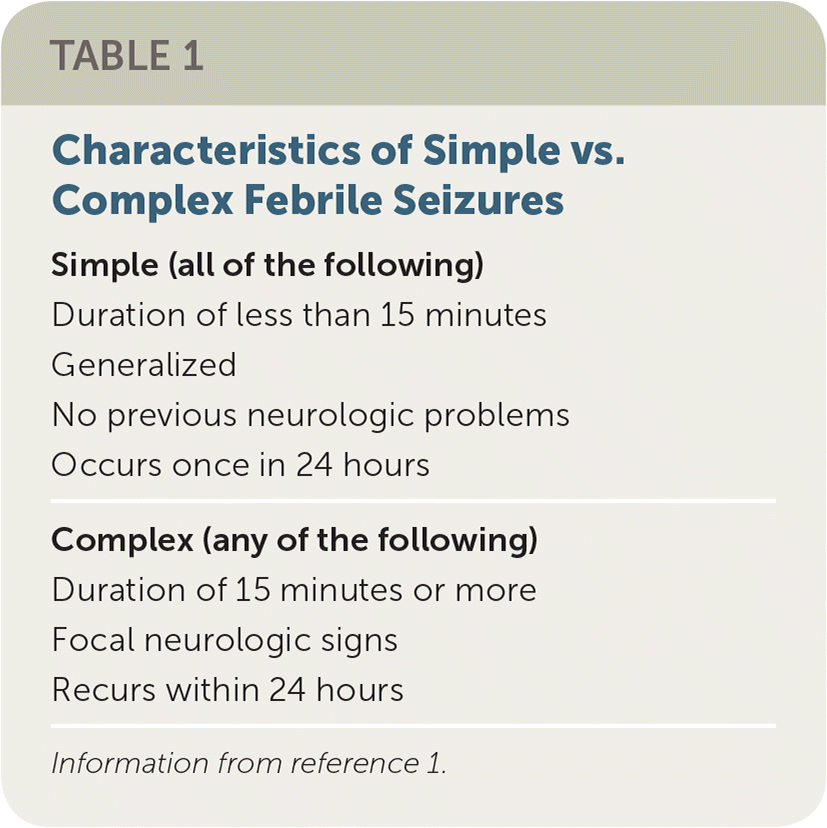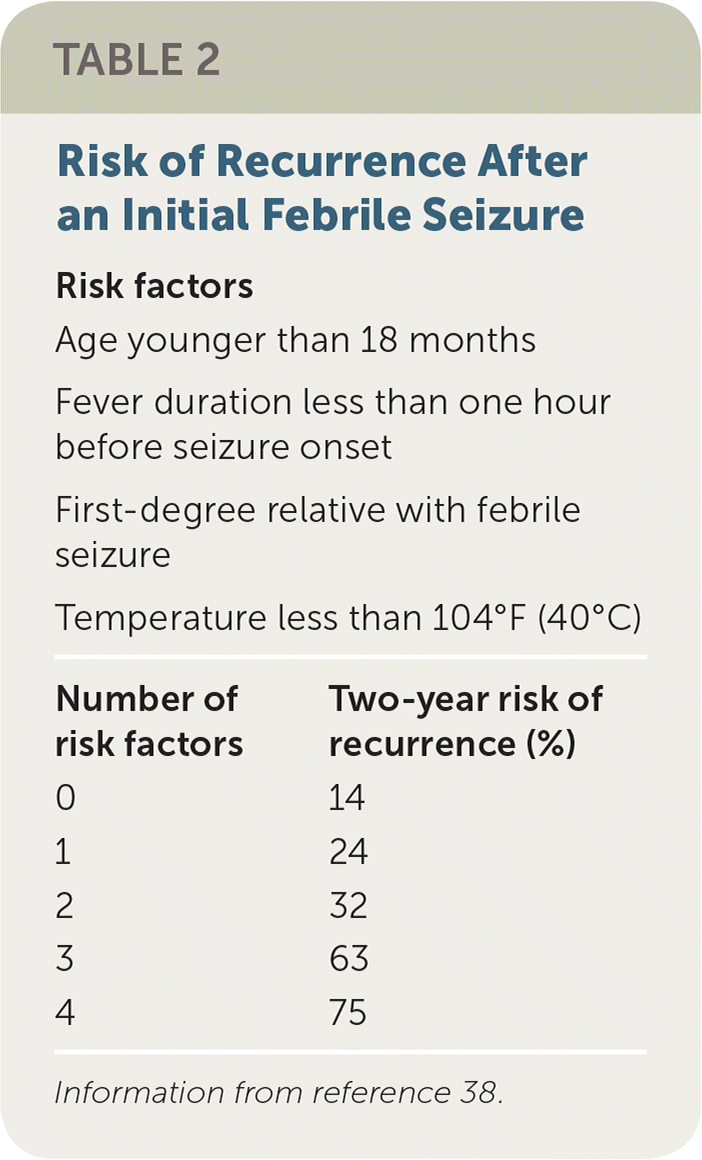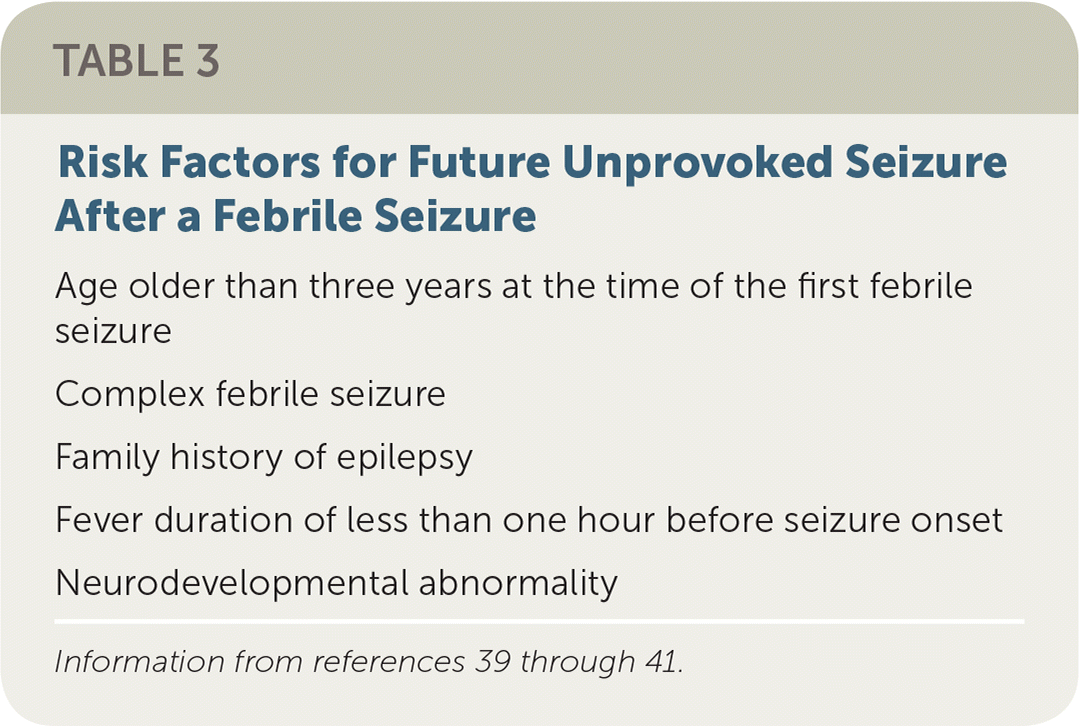
This article is a corrected version of the article that appeared in print.
Am Fam Physician. 2019;99(7):445-450
Author disclosure: No relevant financial affiliations.
A febrile seizure is a seizure occurring in a child six months to five years of age that is accompanied by a fever (100.4°F or greater) without central nervous system infection. Febrile seizures are classified as simple or complex. A complex seizure lasts 15 minutes or more, is associated with focal neurologic findings, or recurs within 24 hours. The cause of febrile seizures is likely multifactorial. Viral illnesses, certain vaccinations, and genetic predisposition are common risk factors that may affect a vulnerable, developing nervous system under the stress of a fever. Children who have a simple febrile seizure and are well-appearing do not require routine diagnostic testing (laboratory tests, neuroimaging, or electroencephalography), except as indicated to discern the cause of the fever. For children with complex seizures, the neurologic examination should guide further evaluation. For seizures lasting more than five minutes, a benzodiazepine should be administered. Febrile seizures are not associated with increased long-term mortality or negative effects on future academic progress, intellect, or behavior. Children with febrile seizures are more likely to have recurrent febrile seizures. However, given the benign nature of febrile seizures, the routine use of antiepileptics is not indicated because of adverse effects of these medications. The use of antipyretics does not decrease the risk of febrile seizures, although rectal acetaminophen reduced the risk of short-term recurrence following a febrile seizure. Parents should be educated on the excellent prognosis of children with febrile seizures and provided with practical guidance on home management of seizures.
A febrile seizure is a seizure occurring in a child six months to five years of age that is accompanied by a fever (100.4°F [38°C] or greater) without central nervous system infection.1 Febrile seizures are classified as simple or complex (Table 1).1 Complex seizures last 15 minutes or more, are associated with focal neurologic findings, or recur within 24 hours. Febrile seizures are the most common convulsive event in childhood, occurring in 2% to 5% of children.1
WHAT IS NEW ON THIS TOPIC
A 2018 randomized trial of 423 children with febrile seizures found that rectal acetaminophen given every six hours for 24 hours significantly reduced the likelihood of short-term recurrence compared with no use of antipyretics.
The measles-mumps-rubella vaccine is associated with an excess risk of 10 febrile seizures per 10,000 children 16 to 23 months of age, but only four seizures per 10,000 children 12 to 15 months. This highlights the importance of providing timely measles-mumps-rubella immunizations.
| Clinical recommendation | Evidence rating | References |
|---|---|---|
| Children with a simple febrile seizure who are well-appearing do not require routine diagnostic testing, such as laboratory tests, neuroimaging, or electroencephalography. | C | 1, 31, 32 |
| Continuous or intermittent antiepileptic medications are not recommended after a first febrile seizure because of potential adverse effects. | B | 42 |
| Antipyretic agents do not reduce recurrence of simple febrile seizures. | A | 42 |
| Risk factors for recurrence of febrile seizure are age younger than 18 months, fever duration of less than one hour before seizure onset, first-degree relative with a history of febrile seizures, and a temperature of less than 104°F (40°C). | B | 38 |

| Recommendation | Sponsoring organization |
|---|---|
| Do not routinely order an electroencephalography for neurologically healthy children who have a simple febrile seizure. | American Academy of Nursing |
| Neuroimaging (computed tomography, magnetic resonance imaging) is not necessary in a child with a simple febrile seizure. | American Academy of Pediatrics |

| Simple (all of the following) |
| Duration of less than 15 minutes |
| Generalized |
| No previous neurologic problems |
| Occurs once in 24 hours |
| Complex (any of the following) |
| Duration of 15 minutes or more |
| Focal neurologic signs |
| Recurs within 24 hours |
Risk Factors
The cause of febrile seizures is likely multifactorial. Viral illnesses, certain vaccinations, and genetic predisposition are common risk factors that may affect a vulnerable, developing nervous system under the stress of a fever. Other risk factors include exposures in utero, such as maternal smoking and maternal stress; being in the neonatal intensive care unit for more than 28 days (odds ratio [OR] = 5.6); developmental delay (OR = 4.9); having a first-degree relative with a history of febrile seizures (OR = 4.5); having a second-degree relative with a history of febrile seizures (OR = 3.6); and day care attendance (OR = 3.1).2–4
Certain genes that have been identified as risk factors for familial epilepsy syndromes may also increase the risk of febrile seizures.5,6 Underlying genetic disorders may increase susceptibility to environmental risk factors. The risk of febrile seizures is related to the height of the temperature elevation, not the rate of temperature rise, and seizure threshold varies by age and individual susceptibilities.3
Viral infections, particularly those associated with high fevers, increase the risk of febrile seizures because high fevers have been shown to increase neuronal excitability and lower the seizure threshold.2 Viruses most commonly correlated with febrile seizures include human herpesvirus 6, influenza, adenovirus, and parainfluenza.7,8
Certain vaccine preparations and associated age at administration have been shown to increase the risk of febrile seizures.9 The measles-mumps-rubella vaccine is associated with an increased risk of febrile seizures (10 additional cases per 10,000 children 16 to 23 months of age, but only four additional cases per 10,000 children 12 to 15 months of age).10,11 Because the increased risk of seizures with measles-containing vaccines is lower when administered at 12 to 15 months, the age recommended by the Centers for Disease Control and Prevention, it is important to provide timely immunizations to mitigate potential risks.11,12 There is also a slight increase in risk in the 24 hours following the administration of the measles-mumps-rubella-varicella vaccine compared with separate measles-mumps-rubella and varicella vaccines (3.5 additional cases per 10,000 children).13
The risk of seizure is not significantly increased following the influenza vaccine or the modern acellular pertussis vaccine.12 Because the sequelae of preventable infections and the importance of maintaining herd immunity are more important than the rare potential complications from vaccinations, the American Academy of Family Physicians and Advisory Committee on Immunization Practices recommend children receive all routine vaccinations.14,15 The Centers for Disease Control and Prevention does not recommend administering antipyretics following immunizations, because this does not prevent febrile seizures and has the potential to decrease antibody response.16
Evaluation
The evaluation of children with febrile seizures should begin with a focused history and physical examination to determine the cause of the fever.1,17–19 Key features of the history include description and duration of the convulsive episode, personal or family history of seizures or epilepsy, recent illness or antibiotic use, recent vaccinations, and immunization status for Haemophilus influenzae type b and Streptococcus pneumoniae.1 Focal neurologic signs or Todd paralysis (i.e., postictal weakness or paralysis, usually on one side of the body) should also be noted because the presence of a focal examination finding would classify the seizure as complex.18
The causes of fever with or without seizure in children are similar. Children with a simple febrile seizure do not have a higher risk of urinary tract infection, pneumonia, bacteremia, or bacterial meningitis.20–23 Therefore, children with a simple febrile seizure who are well-appearing do not require routine diagnostic testing, such as laboratory tests, neuroimaging, or electroencephalography, except as indicated to discern the cause of the fever.1
In patients with complex febrile seizures, the neurologic examination can help determine whether laboratory tests are indicated. Well-appearing children with complex febrile seizures have a low risk of hypoglycemia, and although they may have slightly lower serum sodium levels, those levels do not predict seizure recurrence.24,25 Persistently abnormal mental status between or after seizures should prompt evaluation for hypoglycemia and electrolyte abnormalities.
A febrile seizure in an infant or child raises the concern for meningitis. However, there is no evidence that a well-appearing child with only a simple febrile seizure has an increased risk of bacterial meningitis. In a case series of 503 patients with meningitis occurring over 20 years, all children with a seizure had additional findings suggestive of meningitis, such as obtunded or comatose mental status, nuchal rigidity, prolonged focal seizure, or petechial rash and multiple seizures.26 Retrospective studies of children with a first simple febrile seizure did not identify any cases of bacterial meningitis.23,27 Therefore, the American Academy of Pediatrics does not recommend routine lumbar puncture for well-appearing children with a simple febrile seizure. However, a lumbar puncture may be considered in these patients if they are between six and 12 months of age and have incomplete or unknown immunization status for H. influenzae type b or S. pneumoniae (because signs of meningitis may be less reliable in younger children) or if he or she was pretreated with antibiotics (this may affect the presentation of bacterial meningitis).1,24 [corrected]
Decisions about diagnostic testing may not be as straightforward in children with a complex febrile seizure, because complex febrile seizures are more heterogeneous. The neurologic examination is crucial when deciding whether to perform a lumbar puncture. Children with signs and symptoms of bacterial meningitis should undergo lumbar puncture.28 Febrile status epilepticus should raise suspicion for serious bacterial infection, intracranial abnormality, or toxic ingestion.29 In a single series of 24 children with febrile status epilepticus, acute bacterial meningitis was diagnosed in four of the children; therefore, lumbar puncture should be performed in children with this condition.30
Similarly, the neurologic examination can aid in deciding whether to perform neuroimaging in children with a complex febrile seizure. The risk of intracranial abnormality is low, even in these patients. In a case series of 526 patients with a first complex febrile seizure, only four patients had clinically significant intracranial pathology, and three of those four had obvious findings on physical examination.31 Neuroimaging is not necessary for complex febrile seizures unless the child has abnormal or focal findings on neurologic examination.
Electroencephalography has no role in the acute management of febrile seizures and does not predict recurrence.32 However, outpatient electroencephalography should be performed in children with multiple risk factors for epilepsy (developmental delay, family history of epilepsy, and more than one defining feature of a complex febrile seizure) because of the risk of subsequent nonfebrile seizures.17,29
Acute Management
Prehospital and emergent management should focus on stabilizing the patient (ABCs [airway, breathing, and circulation]). Most febrile seizures are self-limited and end before patients arrive at the hospital. However, seizures lasting longer than five minutes are unlikely to stop on their own, and a benzodiazepine should be administered to break the seizure.19 A 2018 Cochrane review concluded that intravenous lorazepam (Ativan) and diazepam have similar rates of seizure cessation and respiratory depression. When intravenous access is unavailable, buccal midazolam or rectal diazepam (Diastat) is acceptable. The Cochrane review concluded that there is insufficient evidence to support the use of intranasal benzodiazepines.33
Prognosis and Long-Term Management
A population-based cohort study found no increase in long-term mortality in children with simple febrile seizures compared with the general population. Children with complex febrile seizures were more likely to die in the following two years when compared with children without febrile seizures (adjusted mortality rate ratio = 1.99), although this was at least in part secondary to neurologic abnormalities and subsequent epilepsy.36 A prospective cohort study in the United Kingdom found no difference in academic progress, intellect, and behavior at 10 years of age in children who had a simple or complex febrile seizure compared with control patients.37
Children with a first febrile seizure have a 33% risk of a recurrent febrile seizure. Table 2 lists four independent risk factors for recurrent febrile seizure and quantifies the risk based on the combination of those factors.38 There is no difference in risk of recurrence based on whether the initial febrile seizure was simple or complex.38

| Risk factors | |
| Age younger than 18 months | |
| Fever duration less than one hour before seizure onset | |
| First-degree relative with febrile seizure | |
| Temperature less than 104°F (40°C) | |
| Number of risk factors | Two-year risk of recurrence (%) |
| 0 | 14 |
| 1 | 24 |
| 2 | 32 |
| 3 | 63 |
| 4 | 75 |
Based on a cohort study, children with febrile seizures are five times more likely to develop subsequent unprovoked seizures compared with children with no febrile seizures. The risk of epilepsy ranges from 2.4% in children with simple febrile seizures to 6% to 8% in children with complex seizures. Children with any two features of a complex seizure have a 17% to 22% risk of developing an unprovoked seizure, and those with all three features have a 49% risk.39 Table 3 lists the risk factors for a future unprovoked seizure after a febrile seizure.39–41

| Age older than three years at the time of the first febrile seizure |
| Complex febrile seizure |
| Family history of epilepsy |
| Fever duration of less than one hour before seizure onset |
| Neurodevelopmental abnormality |
Prevention
Multiple pharmacologic interventions have been studied to prevent recurrence of febrile seizures. However, potential benefits must be weighed against potential risks. A Cochrane review showed that intermittent diazepam significantly reduced recurrent febrile seizures for up to 48 months compared with placebo or no treatment. Continuous phenobarbital reduced recurrent febrile seizures compared with placebo at 6, 12, and 24 months but not at 18 or 72 months.42
Although an intermittent benzodiazepine or a continuous antiepileptic has clinically and statistically significant benefits, adverse effects occur in up to 30% of patients.42 Given the benign nature of febrile seizures, routine use of these medications is not recommended to reduce recurrence of febrile seizures.42
Ibuprofen and acetaminophen are postulated to decrease the risk of febrile seizure by attenuating the effect of the fever as a trigger for the seizure. A Cochrane review found no benefit of antipyretics for decreasing the risk of febrile seizures.42 However, a recent Japanese unblinded randomized trial of 423 children with febrile seizure found that rectal acetaminophen given every six hours for 24 hours significantly reduced the likelihood of short-term recurrence compared with no antipyretics (9.1% vs. 23.5%; P < .001; number needed to treat = 7).43
It has been suspected that zinc plays a role in febrile seizures because blood and cerebrospinal fluid levels of zinc are significantly lower in children who have had a febrile seizure compared with an afebrile seizure. However, the Cochrane review found no benefit of continuous zinc sulfate supplementation for preventing febrile seizures.42
Anticipatory Guidance
Anticipatory guidance for parents should focus on reassurance, emphasizing the benign nature of febrile seizures and the overall excellent prognosis, even if the seizures recur.19 Physicians may also provide parents with guidance on the initial management of febrile seizures. First, parents should protect the child from injury during the seizure. The child should not be restrained, and nothing should be put in the child's mouth. The child should be placed in the recovery position when the seizure stops. Parents should be aware that the child may be sleepy following the seizure and should be instructed to call 911 if the seizure lasts longer than five minutes.44 Physicians may also provide parents with an estimated risk of febrile seizure recurrence using the tool in Table 2.38
This article updates previous articles on this topic by Graves, et al.,17 and Millar.45
Data Sources: A PubMed search was completed using the key terms febrile seizures and febrile convulsions. The search included meta-analyses, randomized controlled trials, clinical trials, and reviews. We also searched the Cochrane database, Essential Evidence Plus, and the National Guideline Clearinghouse. References in these resources were also searched. Search dates: February 20, 2018; May 1, 2018; August 15, 2018; and December 8, 2018.
The views expressed in this article are those of the authors and do not necessarily reflect the official policy or position of the Department of the Navy, Department of Defense, or the U.S. government.
